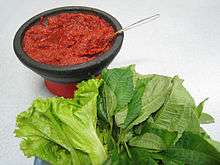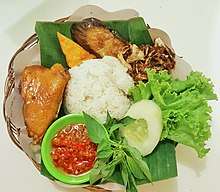Lalab
Lalab or lalap is a Sundanese raw vegetable salad served with sambal terasi. It is a popular Sundanese vegetable dish originated from West Java, Indonesia.[1]
 Lalab platter with sambal | |
| Alternative names | Lalap |
|---|---|
| Place of origin | Indonesia |
| Region or state | West Java, Nationwide |
| Serving temperature | Cold or room temperature |
| Main ingredients | Various raw vegetables served with sambal terasi |
There are no set rules on what vegetables make into lalab, in practice all edible vegetables can be made as lalab. However, the most common raw vegetables are cucumber, tomato, cabbage, lettuce, lemon basil, leunca and long beans. While blanched or boiled vegetables include spinach, papaya leaves and chayote. The dressing for this salad usually is sambal terasi served directly from the stone mortar as a spicy dipping sauce for these assorted raw vegetables.[1]
Today, lalab is popular throughout Indonesia. It is usually served as vegetable side dish next to the main course, such as ayam goreng (fried chicken), ayam bakar (grilled chicken), pepes, pecel lele (fried catfish), fried gourami, and many other ikan goreng (fried fish) or ikan bakar (grilled fish).
History
The history of lalab vegetables is obscure, due to lack of historical records. However, vegetable dishes either raw, boiled or blanched was known as kuluban in ancient Java. Historians believed that kuluban mentioned in the Taji inscription dated 901 CE, is identical if not predecessor or present day lalaban.[2] In the 15th century Sundanese manuscript Sanghyang Siksa Kandang Karesian it was mentioned the common flavour of food in that times are, lawana (salty), kaduka (hot and spicy), tritka (bitter), amba (sour), kasaya (succulent), and madura (sweet). These tastes are native flavour which mostly acquired from plant and vegetables.[3]
Ingredients

Originally, it was made from any available edible young leaves and raw vegetables known by Sundanese since ancient times. Today, though, most lalab consists of sliced cabbage, cucumbers, lettuce, green beans, yardlong beans, tomatoes, leunca, lemon basil, spinach, water spinach, pohpohan leaves (Pilea melastomoides), kenikir leaves (cosmos), cassava leaves, papaya leaves, chayote, and small, green eggplant. Sometimes, other exotic vegetables also are used, such as green, stinky petai and jengkol bean.[4]
Although most lalab vegetables are only washed in cold water and served raw, some boiled, steamed and fried variations are also available; for example, petai green beans can be served either raw or fried, while labu siam (chayote), water spinach and cassava leaves are usually served boiled.
While most of vegetables are served raw or simply boiled or blanched, the main flavouring agent is its dressing, the hot and spicy sambal terasi which is chili paste in terasi shrimp paste. Most of recipes revolved around specific recipe of sambals.[5]
Nutrients

In Indonesian cuisine, lalab often served as garnishing or as vegetable accompaniment to the main meal of fish or chicken; such as ayam goreng (fried chicken) or pecel lele (fried catfish). Lalab is rich in vitamins, minerals and fiber. Daily consumption of fresh vegetables is good for reducing cholesterol levels and improving digestive health. Vegetables are also rich in antioxidants, which contribute to fighting free radicals, and have antiaging and anticancer properties. Several plants used in lalab also are believed to have certain medicinal properties.[6]
See also
- Ulam, a similar Malay dish consists of vegetables, served raw or soaked in hot water
- List of salads
References
- Anita (2013-08-07). "Lalap Sambal Terasi - Sundanese Vegetables with Shrimp Paste Chili Relish - Daily Cooking Quest". Daily Cooking Quest. Retrieved 2017-12-23.
- "Menguak Fakta Menu Lalapan Sunda Lewat Prasasti Taji". beritasatu.com (in Indonesian). Retrieved 2017-12-23.
- "Terungkap, Asal Mula Menu Lalapan | Dream.co.id". Dream.co.id (in Indonesian). Retrieved 2017-12-23.
- "Lalab dalam Kehidupan Masyarakat Sunda". 20 Oct 2008.
- "Lalab Platter With Sambal Terasi Recipe - Genius Kitchen". Retrieved 2017-12-23.
- Khasiat Lalapan (in Indonesian) Archived 2011-10-11 at the Wayback Machine
External links
| Wikimedia Commons has media related to Lalab. |